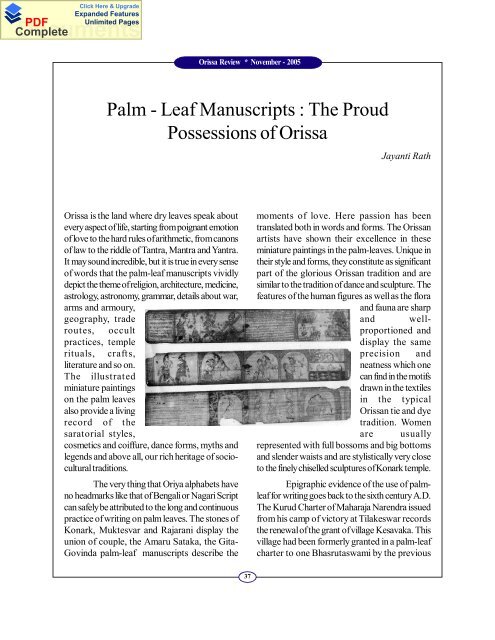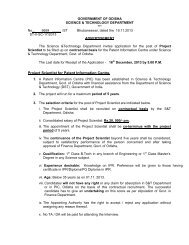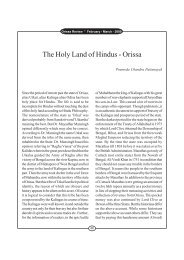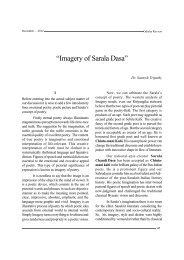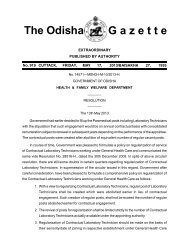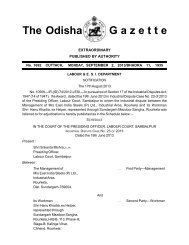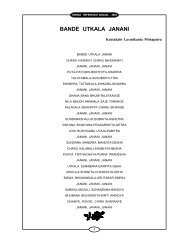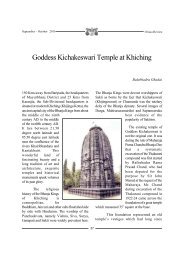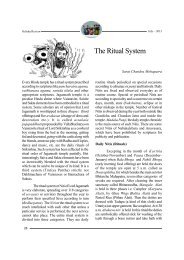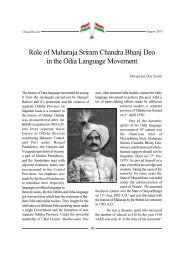Palm- Leaf Manuscripts: The Proud Possessions of Orissa
Palm- Leaf Manuscripts: The Proud Possessions of Orissa
Palm- Leaf Manuscripts: The Proud Possessions of Orissa
Create successful ePaper yourself
Turn your PDF publications into a flip-book with our unique Google optimized e-Paper software.
PDF<br />
Documents<br />
Complete<br />
Click Here & Upgrade<br />
Expanded Features<br />
Unlimited Pages<br />
<strong>Orissa</strong> Review * November - 2005<br />
<strong>Palm</strong> - <strong>Leaf</strong> <strong>Manuscripts</strong> : <strong>The</strong> <strong>Proud</strong><br />
<strong>Possessions</strong> <strong>of</strong> <strong>Orissa</strong><br />
Jayanti Rath<br />
<strong>Orissa</strong> is the land where dry leaves speak about<br />
every aspect <strong>of</strong> life, starting from poignant emotion<br />
<strong>of</strong> love to the hard rules <strong>of</strong> arithmetic, from canons<br />
<strong>of</strong> law to the riddle <strong>of</strong> Tantra, Mantra and Yantra.<br />
It may sound incredible, but it is true in every sense<br />
<strong>of</strong> words that the palm-leaf manuscripts vividly<br />
depict the theme <strong>of</strong> religion, architecture, medicine,<br />
astrology, astronomy, grammar, details about war,<br />
arms and armoury,<br />
geography, trade<br />
routes, occult<br />
practices, temple<br />
rituals, crafts,<br />
literature and so on.<br />
<strong>The</strong> illustrated<br />
miniature paintings<br />
on the palm leaves<br />
also provide a living<br />
record <strong>of</strong> the<br />
saratorial styles,<br />
cosmetics and coiffure, dance forms, myths and<br />
legends and above all, our rich heritage <strong>of</strong> sociocultural<br />
traditions.<br />
<strong>The</strong> very thing that Oriya alphabets have<br />
no headmarks like that <strong>of</strong> Bengali or Nagari Script<br />
can safely be attributed to the long and continuous<br />
practice <strong>of</strong> writing on palm leaves. <strong>The</strong> stones <strong>of</strong><br />
Konark, Muktesvar and Rajarani display the<br />
union <strong>of</strong> couple, the Amaru Sataka, the Gita-<br />
Govinda palm-leaf manuscripts describe the<br />
moments <strong>of</strong> love. Here passion has been<br />
translated both in words and forms. <strong>The</strong> <strong>Orissa</strong>n<br />
artists have shown their excellence in these<br />
miniature paintings in the palm-leaves. Unique in<br />
their style and forms, they constitute as significant<br />
part <strong>of</strong> the glorious <strong>Orissa</strong>n tradition and are<br />
similar to the tradition <strong>of</strong> dance and sculpture. <strong>The</strong><br />
features <strong>of</strong> the human figures as well as the flora<br />
and fauna are sharp<br />
and wellproportioned<br />
and<br />
display the same<br />
precision and<br />
neatness which one<br />
can find in the motifs<br />
drawn in the textiles<br />
in the typical<br />
<strong>Orissa</strong>n tie and dye<br />
tradition. Women<br />
are usually<br />
represented with full bossoms and big bottoms<br />
and slender waists and are stylistically very close<br />
to the finely chiselled sculptures <strong>of</strong> Konark temple.<br />
Epigraphic evidence <strong>of</strong> the use <strong>of</strong> palmleaf<br />
for writing goes back to the sixth century A.D.<br />
<strong>The</strong> Kurud Charter <strong>of</strong> Maharaja Narendra issued<br />
from his camp <strong>of</strong> victory at Tilakeswar records<br />
the renewal <strong>of</strong> the grant <strong>of</strong> village Kesavaka. This<br />
village had been formerly granted in a palm-leaf<br />
charter to one Bhasrutaswami by the previous<br />
37
PDF<br />
Documents<br />
Complete<br />
Click Here & Upgrade<br />
Expanded Features<br />
Unlimited Pages<br />
<strong>Orissa</strong> Review * November - 2005<br />
king, but as the palm-leaf was destroyed in fire,<br />
Maharaja Narendra regranted it in a copper plate<br />
charter in favour <strong>of</strong> Sankhaswami, son <strong>of</strong><br />
Bhasrutaswami. Maharaja Narendra was a<br />
Sarabhapuriya king <strong>of</strong> South Kosala in the 6th<br />
century A.D.<br />
<strong>The</strong>re are also many sculptural evidences<br />
regarding the use <strong>of</strong> palm-leaf manuscripts. <strong>The</strong><br />
earliest <strong>of</strong> these can be found in the Parsuramesvar<br />
temple at Bhubaneswar which was built during<br />
the rule <strong>of</strong> Sailodbhava dynasty (7th Century<br />
A.D.). Similar representations can be observed<br />
in the Muktesvar temple (10th century A.D.) and<br />
also the famous Sun temple <strong>of</strong> Konark (13th<br />
century A.D.). Another important sculptural<br />
evidence is an image <strong>of</strong> Buddha found at a temple<br />
in Haripur near Khurdha. In this sculpture one<br />
finds in the pedestal a scholar studying some holy<br />
scriptures in the shape <strong>of</strong> a stringed palm-leaf<br />
manuscript placed on Vyasasana. <strong>The</strong>re is a<br />
beautiful presentation <strong>of</strong> a scribe writing with a<br />
stylus on a palm-leaf in a sculpture <strong>of</strong> Jagannath<br />
temple <strong>of</strong> Dharakot.<br />
<strong>The</strong> entire Buddhist scripture<br />
Avatamsaka Sutra was written on palm-leaf<br />
manuscript and it was presented to Chinese<br />
emperor Te-Song by Subhakara Deva, the<br />
Bhaumakara king <strong>of</strong> <strong>Orissa</strong> with his own<br />
autograph. This was an event <strong>of</strong> eight century (798<br />
A.D.).<br />
<strong>The</strong> oldest datable palm-leaf manuscript<br />
now exant in <strong>Orissa</strong> State Museum is a copy <strong>of</strong><br />
the poetic work Abhinava Gita Govinda by Kavi<br />
Chandra Ray Divakara Mishra, inscribed by one<br />
Sri Sridhara Sharma. <strong>The</strong> date <strong>of</strong> the manuscript<br />
has been established as 6th April, 1494. <strong>The</strong> poet<br />
has <strong>of</strong>fered the work in the name <strong>of</strong> Gajapati<br />
Purushottama Deva.<br />
<strong>The</strong> concluding portion <strong>of</strong> the manuscript<br />
is called Pushpika or Colophon. It gives the name<br />
<strong>of</strong> the scribe and the date <strong>of</strong> copying just as we<br />
have today the name <strong>of</strong> the author and the<br />
publisher and the date <strong>of</strong> the publication <strong>of</strong> a<br />
printed book on its title page. In recording the<br />
date in the colophon, the scribe followed the anka<br />
or the regnal year <strong>of</strong> the Raja <strong>of</strong> Puri. <strong>The</strong> colophon<br />
sometimes mention the Oriya Sala or Sana year<br />
<strong>of</strong> an era which started on the twelfth day <strong>of</strong> bright<br />
fortnight <strong>of</strong> the Bhadra month <strong>of</strong> 593 A.D. During<br />
the reign <strong>of</strong> Akbar, Hijra or Amali Era was<br />
introduced in the manuscripts. In a few latter<br />
manuscripts, the Christian era called Samvatsara<br />
and the Christian month are given in colophon.<strong>The</strong><br />
Saka Era (Starting in 78 A.D.) has also been used.<br />
Sometimes the year has been given in a riddle or<br />
chronogram.<br />
In case <strong>of</strong> illustrated palm-leaf<br />
manuscripts, the introduction was always made<br />
with the picture <strong>of</strong> Ganesha, the god <strong>of</strong> learning<br />
and well being with the words Shri Ganeshaya<br />
Namah (Salutation to Ganesha) and Shri Shubham<br />
astu (let it be auspicious). Some Chitrapothis also<br />
had the picture <strong>of</strong> Sarasvati, the goddess <strong>of</strong><br />
learning on the front page. If the manuscript<br />
contained erotic text, (Rati-bandha) - it invariably<br />
had a picture <strong>of</strong> Kandarpa, the God <strong>of</strong> love. In<br />
many <strong>of</strong> Upendra Bhanjas Kavyas, the poet is<br />
shown paying his obeissance to Rama, Vishnu and<br />
other Gods.<br />
<strong>Palm</strong>-leaves and stylus were adopted as<br />
the sole writing material for writing the charya-<br />
Songs which are believed to be the oldest Oriya<br />
literary works. <strong>The</strong>se were composed in a period<br />
between 9th to 12th century A.D. Between the<br />
Charya Songs and Sarala Dass Mahabharata,<br />
no Oriya literary works have come to notice<br />
except some prose writing and a poem called<br />
Kalasa Chautisa. During this period, however,<br />
<strong>Orissa</strong> produced an enormous amount <strong>of</strong> Sanskrit<br />
literature, which includes books on astronomy,<br />
astrology, medicines. grammar, religion and law.<br />
38
PDF<br />
Documents<br />
Complete<br />
Click Here & Upgrade<br />
Expanded Features<br />
Unlimited Pages<br />
<strong>Orissa</strong> Review * November - 2005<br />
Several commentaries were written on wellknown<br />
Sanskrit works. <strong>The</strong>re were also an<br />
outpouring <strong>of</strong> literary works, the best known <strong>of</strong><br />
which are Anargha Raghava <strong>of</strong> Murari Mishra,<br />
Gita Govinda <strong>of</strong> Sri Jayadev and Sahitya Darpana<br />
<strong>of</strong> Viswanath Kaviraj.<br />
By the fifteenth century the art <strong>of</strong> palmleaf<br />
writing had attained great excellence. <strong>The</strong><br />
innumerable copies <strong>of</strong> Sarala Mahabharata were<br />
written on palm-leaf manuscripts and spread<br />
throughout <strong>Orissa</strong>. By the way, the great poet and<br />
the great monarch, Gajapati Kapilendra Dev <strong>of</strong><br />
Suryavamsi dynasty, who ruled <strong>Orissa</strong> at that time<br />
became indelible in history. <strong>The</strong> manuscripts <strong>of</strong><br />
Bhagabata <strong>of</strong> the poet Jagannath Das, had still<br />
far greater influence over the common people <strong>of</strong><br />
<strong>Orissa</strong>. Balaram Dass Jagamohan Ramayana<br />
was also accepted with much reverence for its<br />
lucid style. Practically speaking, these three were<br />
the most widely read books in <strong>Orissa</strong> by that time.<br />
With the advent <strong>of</strong> Shri Chaitanya to <strong>Orissa</strong> in<br />
1510 A.D. and the spread <strong>of</strong> Vaishnavism, the<br />
Oriya Bhagabata achieved unprecedental<br />
popularity. Community houses called Bhagabata<br />
Gharas or Bhagabata Tungi sprang up in the<br />
villages <strong>of</strong> <strong>Orissa</strong> where copies <strong>of</strong> Bhagabat were<br />
kept and recited daily. <strong>The</strong> reading <strong>of</strong> the chapters<br />
<strong>of</strong> the holy scriptures became a daily ritual in the<br />
homes <strong>of</strong> Oriya people. Thus, the Bhagabata<br />
Pothi brought pr<strong>of</strong>ound vibration in the entire<br />
social life <strong>of</strong> <strong>Orissa</strong>.<br />
During the sixteenth and seventeenth<br />
centuries a large number <strong>of</strong> Kavyas or long<br />
episodical poems were written in Oriya, all based<br />
on Krishna theme.<br />
<strong>The</strong> most outstanding <strong>of</strong> these Kavyas are<br />
Bhakta Charan Dass Mathura Mangala, Rupa<br />
Goswamis Bidagdha Madhava and Dina<br />
Krushna Dass Rasa Kallola. Several other<br />
translations <strong>of</strong> Ramayana also appeared, the more<br />
popular ones being the versions <strong>of</strong> Adhyatma<br />
Ramayana by Gopala Telenga and Haladhara Das<br />
and Vichitra Ramayana by Viswanath Khuntia.<br />
Another popular manuscript <strong>of</strong> this period was<br />
Sishu Shankar Dass Ushabhilasha, based on a<br />
story <strong>of</strong> Sarala Mahabharata. New poetic forms<br />
also emerged during this period viz, Janana (song<br />
<strong>of</strong> prayer), Chautisa (songs which followed the<br />
thirty-four consonants <strong>of</strong> Oriya alphabets) and Poi<br />
(referring to the number <strong>of</strong> verses in the poems),<br />
i.e. Dasa Poi - meaning a ten-verse poem.<br />
<strong>Orissa</strong> lost her independence in 1568<br />
A.D. and was successively overrun by Afghans,<br />
Mughals and Marathas. Till the British conquest<br />
in 1803, <strong>Orissa</strong> was a veritable cockpit <strong>of</strong> rival<br />
warlords. <strong>The</strong>re was no peace and security. In<br />
the absence <strong>of</strong> a stable central power, <strong>Orissa</strong><br />
broke up into a number <strong>of</strong> semi-independent<br />
principalities under local Rajas. <strong>The</strong> feudal chiefs<br />
patronized art, music and literature as pastimes.<br />
<strong>The</strong> brilliant literary figures <strong>of</strong> this period<br />
was Upendra Bhanja, who was a prince himself.<br />
A prolific poet, he created volumes <strong>of</strong> literary<br />
works. He was the master <strong>of</strong> ornate poetry and<br />
each <strong>of</strong> his work is an example <strong>of</strong> his mastery<br />
over some particular versifying skill or other.<br />
Through clever manipulation <strong>of</strong> words and with a<br />
liberal use <strong>of</strong> puns, alliterations, assonances and<br />
figures <strong>of</strong> speech, he built up a body <strong>of</strong> poetry<br />
which was gaudy and grandeloquent and at the<br />
same time pedantic and unintelligible. He<br />
composed songs, Kavyas, epics, fictional poems,<br />
rhetorical compositions. Chitra-kavya (picturepoem)<br />
and even a dictionary <strong>of</strong> verse for the use<br />
<strong>of</strong> poets. Vaidehisha Vilas, Koti Brahmanda<br />
Sundari, Prema Sudhanidhi, Lavanyabati are<br />
some <strong>of</strong> his memorable works.<br />
<strong>The</strong> style <strong>of</strong> Bhanja prevailed till the<br />
second half <strong>of</strong> the 19th century. All the poets who<br />
emerged after Upendra Bhanja followed his style.<br />
39
PDF<br />
Documents<br />
Complete<br />
Click Here & Upgrade<br />
Expanded Features<br />
Unlimited Pages<br />
<strong>Orissa</strong> Review * November - 2005<br />
<strong>The</strong> name <strong>of</strong> Brajanath Badajena, an eminent poet<br />
<strong>of</strong> post-Bhanja era can be cited as an example.<br />
During this said period, thousands <strong>of</strong> palm-leaf<br />
manuscripts were copied for large scale<br />
circulation. Numerous Chitra-pothis were also<br />
prepared during this period, though many <strong>of</strong> the<br />
extant chitra-pothis seem to have been done<br />
towards the later part <strong>of</strong> the 19th century A.D.<br />
Though paper was in use during this time, poets<br />
did their writing on palm-leaf as this was<br />
considered sacred. <strong>The</strong> Oriya script used in Pothis<br />
did not undergo much <strong>of</strong> a change from its fifteenth<br />
century form.<br />
Oriya printing was introduced by<br />
Christian missionaries after the British conquest<br />
<strong>of</strong> 1803. An Oriya type-face was devised in<br />
1804. Today, the use <strong>of</strong> palm-leaf and stylus has<br />
been diminished a lot. Now at the outset <strong>of</strong><br />
twenty-first century, when the world has become<br />
technocratic, the use <strong>of</strong> fragile palm-leaves has<br />
become irrelevant. But the age-old practice <strong>of</strong><br />
writing on palm-leaf has not been extinguished<br />
from our cultural heritage. Writing on palm-leaf<br />
has many ritual uses in <strong>Orissa</strong>. On Raksha<br />
Panchami day (fifth day <strong>of</strong> the dark <strong>of</strong> fortnight <strong>of</strong><br />
Bhadra month), painting <strong>of</strong> Batuka Bhairava (an<br />
aspect <strong>of</strong> Siva) is done on doors with an<br />
invocation to Siva written on it.<br />
In the Jagannath temple <strong>of</strong> Puri, a letter is<br />
written on palm-leaf on behalf <strong>of</strong> Rukmini to be<br />
delivered to Jagannath on the eleventh day <strong>of</strong><br />
bright fortnight <strong>of</strong> Jyestha month (also known as<br />
Rukmini Harana Ekadasi). In <strong>Orissa</strong>, horoscopes<br />
<strong>of</strong> new born babies are also written on palmleaves.<br />
Similarly, the invitation sent to the deities,<br />
known as Diyan Nimantrana as well as the<br />
ceremonial invitation to the bride-groom from the<br />
brides family is generally written on palm-leaf in<br />
<strong>Orissa</strong>.<br />
Thus, the tradition <strong>of</strong> palm-leaf writing is<br />
still alive. In the past, the palm-leaf manuscripts<br />
were the medium <strong>of</strong> learning, while in the changing<br />
scenario <strong>of</strong> present, it has become the object <strong>of</strong><br />
analysis and retrospection.<br />
References :<br />
1. Chitra Pothi - Dr. J.P. Das, New Delhi, 1985.<br />
2. Illustrated <strong>Palm</strong>-<strong>Leaf</strong> <strong>Manuscripts</strong> <strong>of</strong> <strong>Orissa</strong><br />
(A selection from <strong>Orissa</strong> State Museum),<br />
Bhubaneswar, 1984.<br />
Jayanti Rath is the Asst. Curator, <strong>Orissa</strong> State Museum,<br />
Bhubaneswar-14.<br />
Pattachitra<br />
40


